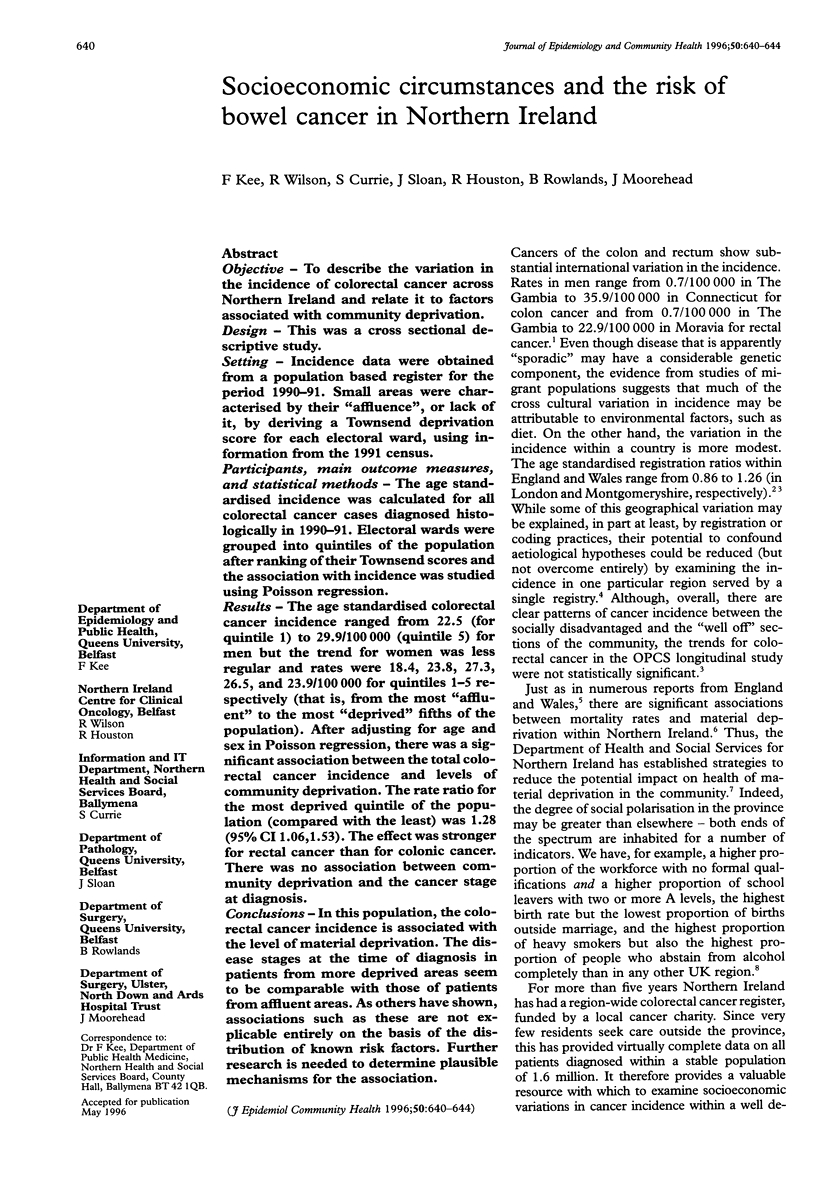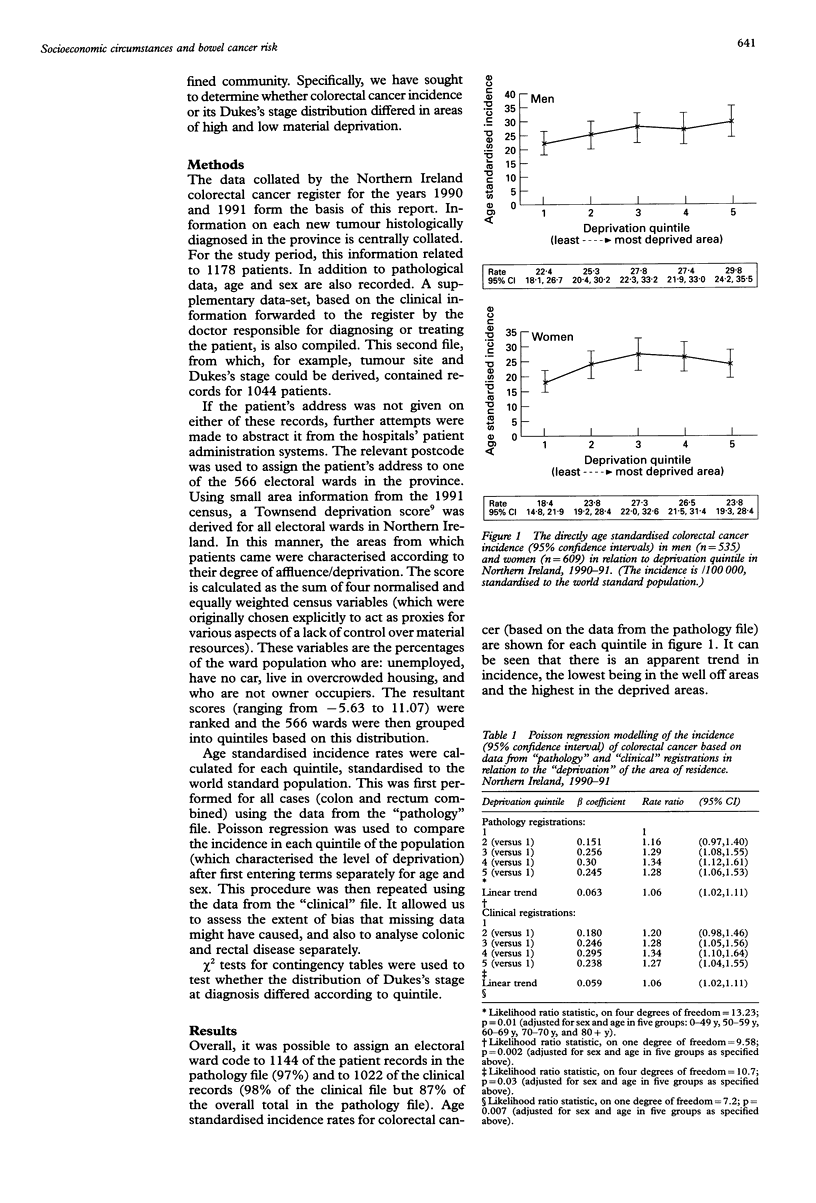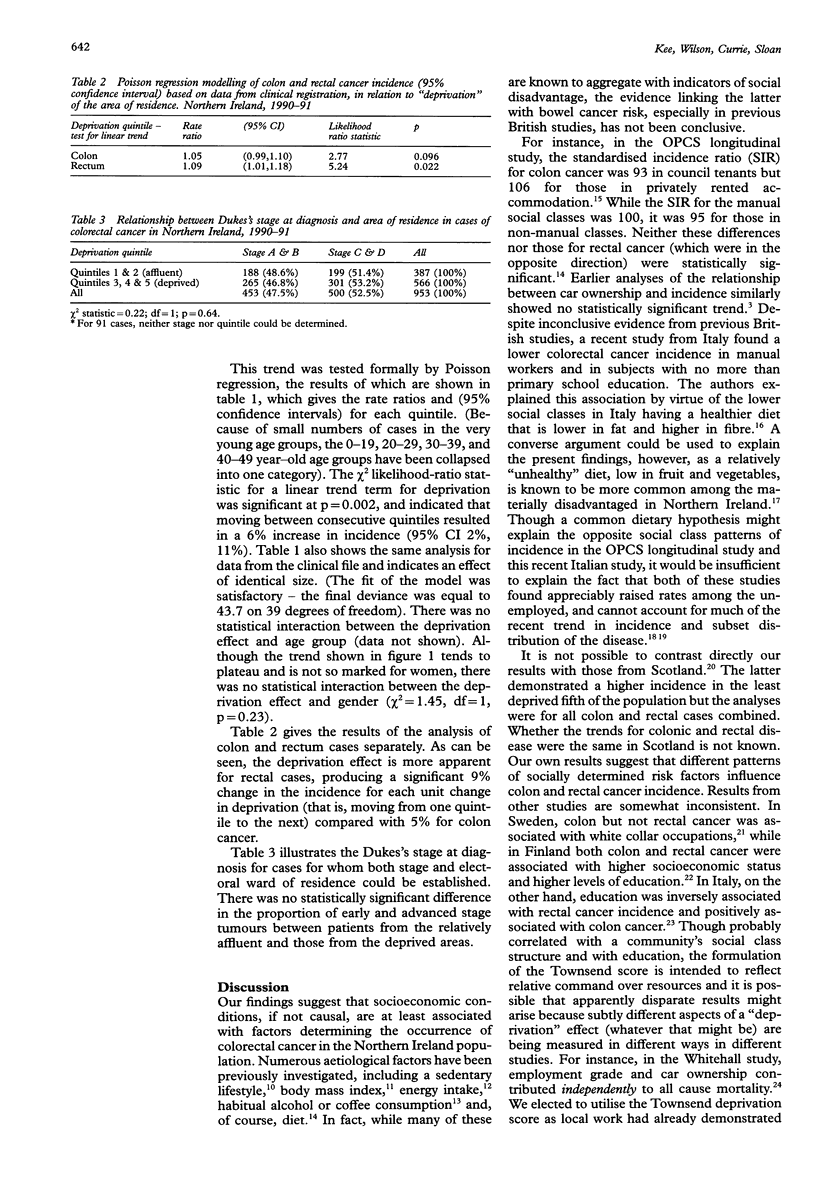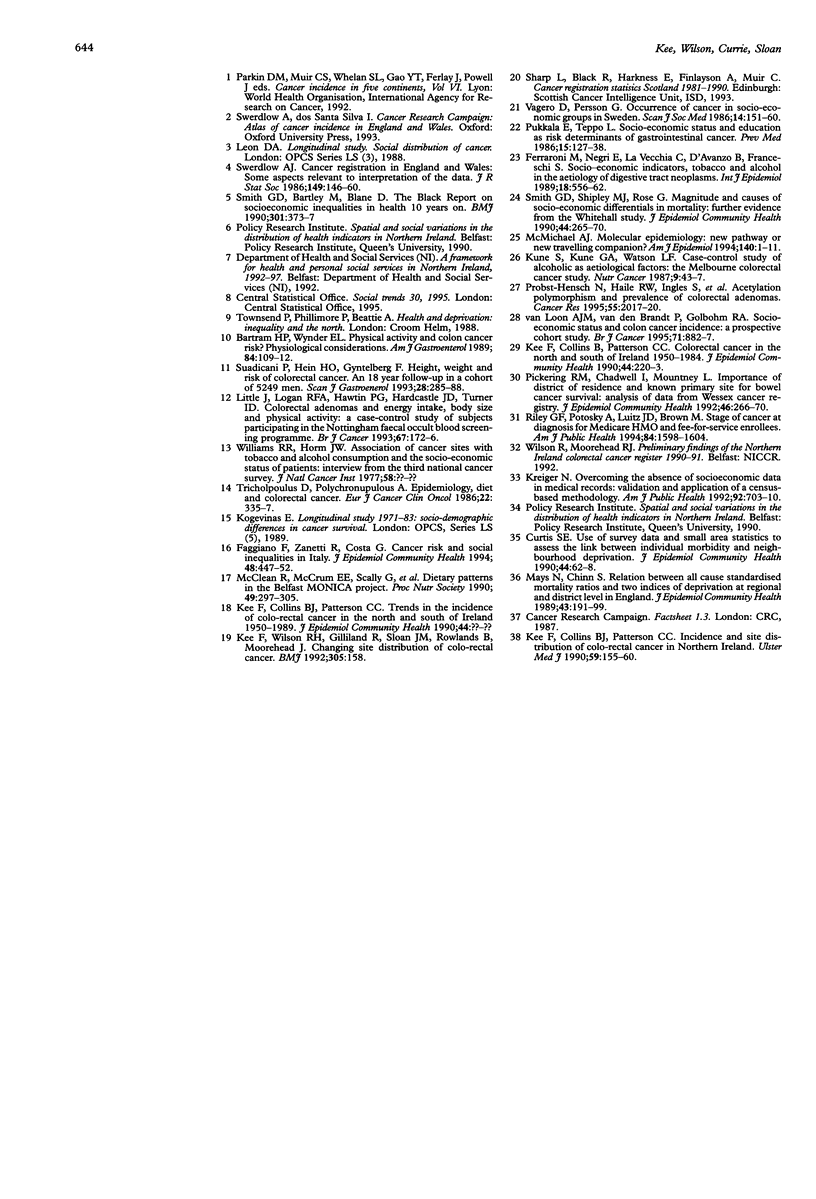Abstract
OBJECTIVE: To describe the variation in the incidence of colorectal cancer across Northern Ireland and relate it to factors associated with community deprivation. DESIGN: This was a cross sectional descriptive study. SETTING: Incidence data were obtained from a population based register for the period 1990-91. Small areas were characterised by their "affluence", or lack of it, by deriving a Townsend deprivation score for each electoral ward, using information from the 1991 census. PARTICIPANTS, MAIN OUTCOME MEASURES, AND STATISTICAL METHODS: The age standardised incidence was calculated for all colorectal cancer cases diagnosed histologically in 1990-91. Electoral wards were grouped into quintiles of the population after ranking of their Townsend scores and the association with incidence was studied using Poisson regression. RESULTS: The age standardised colorectal cancer incidence ranged from 22.5 (for quintile 1) to 29.9/100,000 (quintile 5) for men but the trend for women was less regular and rates were 18.4, 23.8, 27.3, 26.5, and 23.9/100,000 for quintiles 1-5 respectively (that is, from the most "affluent" to the most "deprived" fifths of the population). After adjusting for age and sex in Poisson regression, there was a significant association between the total colorectal cancer incidence and levels of community deprivation. The rate ratio for the most deprived quintile of the population (compared with the least) was 1.28 (95% CI 1.06,1.53). The effect was stronger for rectal cancer than for colonic cancer. There was no association between community deprivation and the cancer stage at diagnosis. CONCLUSIONS: In this population, the colorectal cancer incidence is associated with the level of material deprivation. The disease stages at the time of diagnosis in patients from more deprived areas seem to be comparable with those of patients from affluent areas. As others have shown, associations such as these are not explicable entirely on the basis of the distribution of known risk factors. Further research is needed to determine plausible mechanisms for the association.
Full text
PDF




Selected References
These references are in PubMed. This may not be the complete list of references from this article.
- Bartram H. P., Wynder E. L. Physical activity and colon cancer risk? Physiological considerations. Am J Gastroenterol. 1989 Feb;84(2):109–112. [PubMed] [Google Scholar]
- Curtis S. E. Use of survey data and small area statistics to assess the link between individual morbidity and neighbourhood deprivation. J Epidemiol Community Health. 1990 Mar;44(1):62–68. doi: 10.1136/jech.44.1.62. [DOI] [PMC free article] [PubMed] [Google Scholar]
- Faggiano F., Zanetti R., Costa G. Cancer risk and social inequalities in Italy. J Epidemiol Community Health. 1994 Oct;48(5):447–452. doi: 10.1136/jech.48.5.447. [DOI] [PMC free article] [PubMed] [Google Scholar]
- Ferraroni M., Negri E., La Vecchia C., D'Avanzo B., Franceschi S. Socioeconomic indicators, tobacco and alcohol in the aetiology of digestive tract neoplasms. Int J Epidemiol. 1989 Sep;18(3):556–562. doi: 10.1093/ije/18.3.556. [DOI] [PubMed] [Google Scholar]
- Kee F., Collins B. J., Patterson C. C. Incidence and site distribution of colorectal cancer in Northern Ireland. Ulster Med J. 1990 Oct;59(2):155–160. [PMC free article] [PubMed] [Google Scholar]
- Kee F., Patterson C., Collins B. Colorectal cancer in the north and south of Ireland 1950-1984. J Epidemiol Community Health. 1990 Sep;44(3):220–223. doi: 10.1136/jech.44.3.220. [DOI] [PMC free article] [PubMed] [Google Scholar]
- Kee F., Wilson R. H., Gilliland R., Sloan J. M., Rowlands B. J., Moorehead R. J. Changing site distribution of colorectal cancer. BMJ. 1992 Jul 18;305(6846):158–158. doi: 10.1136/bmj.305.6846.158. [DOI] [PMC free article] [PubMed] [Google Scholar]
- Kune S., Kune G. A., Watson L. F. Case-control study of alcoholic beverages as etiological factors: the Melbourne Colorectal Cancer Study. Nutr Cancer. 1987;9(1):43–56. doi: 10.1080/01635588709513909. [DOI] [PubMed] [Google Scholar]
- Little J., Logan R. F., Hawtin P. G., Hardcastle J. D., Turner I. D. Colorectal adenomas and energy intake, body size and physical activity: a case-control study of subjects participating in the Nottingham faecal occult blood screening programme. Br J Cancer. 1993 Jan;67(1):172–176. doi: 10.1038/bjc.1993.30. [DOI] [PMC free article] [PubMed] [Google Scholar]
- Mays N., Chinn S. Relation between all cause standardised mortality ratios and two indices of deprivation at regional and district level in England. J Epidemiol Community Health. 1989 Jun;43(2):191–199. doi: 10.1136/jech.43.2.191. [DOI] [PMC free article] [PubMed] [Google Scholar]
- McClean R., McCrum E., Scally G., McMaster D., Patterson C., Jackson N., Evans A. Dietary patterns in the Belfast MONICA Project. Proc Nutr Soc. 1990 Jul;49(2):297–305. doi: 10.1079/pns19900033. [DOI] [PubMed] [Google Scholar]
- McMichael A. J. Invited commentary--"molecular epidemiology": new pathway or new travelling companion? Am J Epidemiol. 1994 Jul 1;140(1):1–11. doi: 10.1093/oxfordjournals.aje.a117153. [DOI] [PubMed] [Google Scholar]
- Pickering R. M., Chadwell I. R., Mountney L. Importance of district of residence and known primary site for bowel cancer survival: analysis of data from Wessex Cancer Registry. J Epidemiol Community Health. 1992 Jun;46(3):266–270. doi: 10.1136/jech.46.3.266. [DOI] [PMC free article] [PubMed] [Google Scholar]
- Probst-Hensch N. M., Haile R. W., Ingles S. A., Longnecker M. P., Han C. Y., Lin B. K., Lee D. B., Sakamoto G. T., Frankl H. D., Lee E. R. Acetylation polymorphism and prevalence of colorectal adenomas. Cancer Res. 1995 May 15;55(10):2017–2020. [PubMed] [Google Scholar]
- Pukkala E., Teppo L. Socioeconomic status and education as risk determinants of gastrointestinal cancer. Prev Med. 1986 Mar;15(2):127–138. doi: 10.1016/0091-7435(86)90083-6. [DOI] [PubMed] [Google Scholar]
- Riley G. F., Potosky A. L., Lubitz J. D., Brown M. L. Stage of cancer at diagnosis for Medicare HMO and fee-for-service enrollees. Am J Public Health. 1994 Oct;84(10):1598–1604. doi: 10.2105/ajph.84.10.1598. [DOI] [PMC free article] [PubMed] [Google Scholar]
- Smith G. D., Bartley M., Blane D. The Black report on socioeconomic inequalities in health 10 years on. BMJ. 1990 Aug 18;301(6748):373–377. doi: 10.1136/bmj.301.6748.373. [DOI] [PMC free article] [PubMed] [Google Scholar]
- Smith G. D., Shipley M. J., Rose G. Magnitude and causes of socioeconomic differentials in mortality: further evidence from the Whitehall Study. J Epidemiol Community Health. 1990 Dec;44(4):265–270. doi: 10.1136/jech.44.4.265. [DOI] [PMC free article] [PubMed] [Google Scholar]
- Suadicani P., Hein H. O., Gyntelberg F. Height, weight, and risk of colorectal cancer. An 18-year follow-up in a cohort of 5249 men. Scand J Gastroenterol. 1993 Mar;28(3):285–288. doi: 10.3109/00365529309096087. [DOI] [PubMed] [Google Scholar]
- Trichopoulos D., Polychronopoulou A. Epidemiology, diet and colorectal cancer. Eur J Cancer Clin Oncol. 1986 Mar;22(3):335–337. doi: 10.1016/0277-5379(86)90401-3. [DOI] [PubMed] [Google Scholar]
- Vågerö D., Persson G. Occurrence of cancer in socioeconomic groups in Sweden. An analysis based on the Swedish Cancer Environment Registry. Scand J Soc Med. 1986;14(3):151–160. doi: 10.1177/140349488601400308. [DOI] [PubMed] [Google Scholar]
- van Loon A. J., van den Brandt P. A., Golbohm R. A. Socioeconomic status and colon cancer incidence: a prospective cohort study. Br J Cancer. 1995 Apr;71(4):882–887. doi: 10.1038/bjc.1995.170. [DOI] [PMC free article] [PubMed] [Google Scholar]


